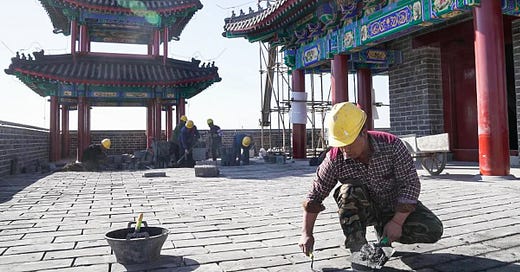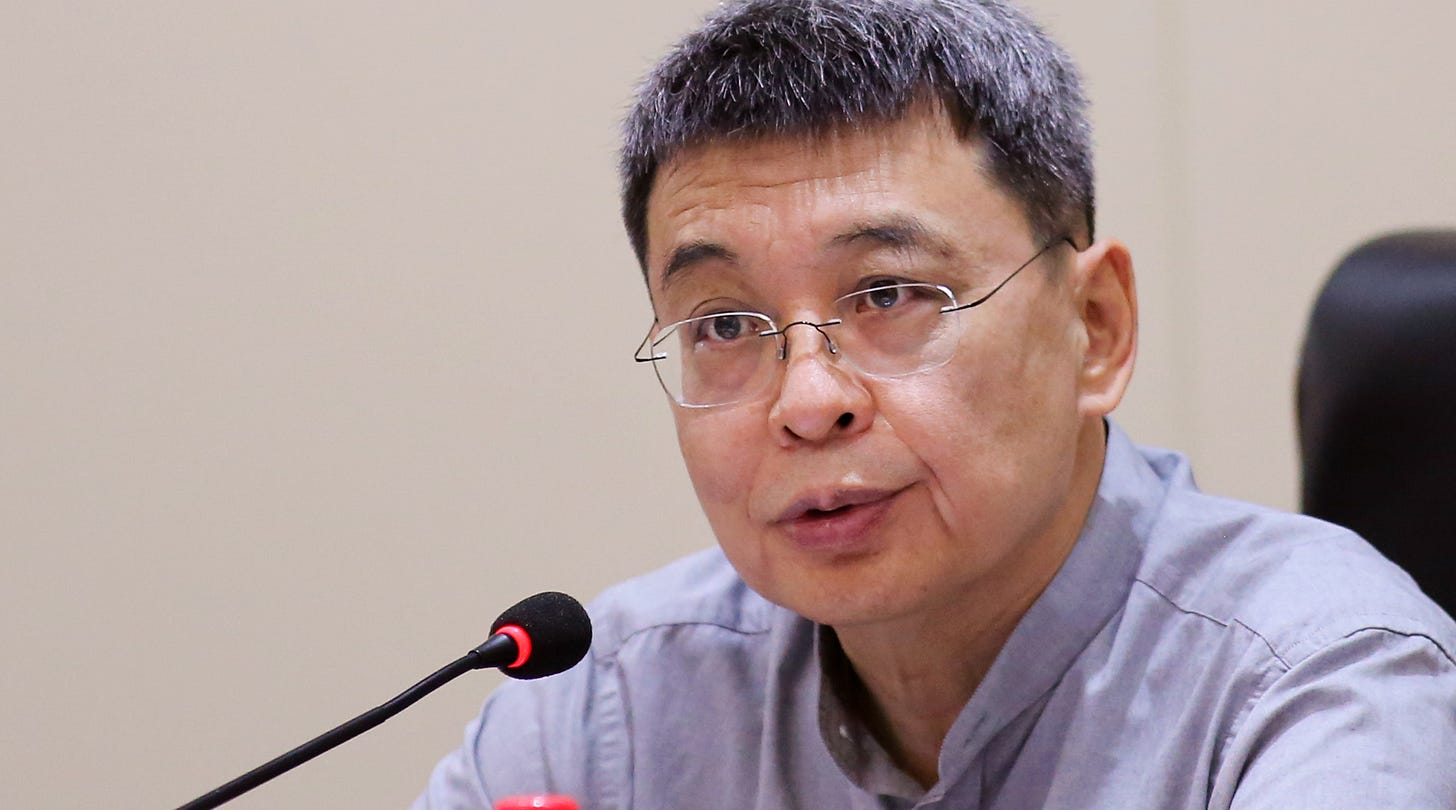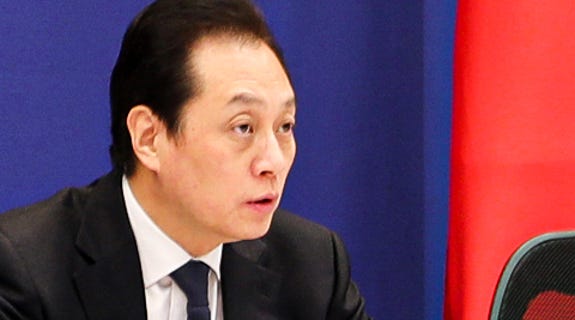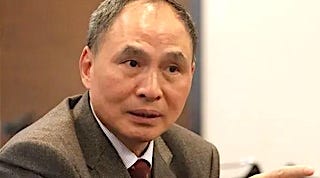Kalos Lau is a governance and law analyst at CHINA POLICY. David Kelly is co-founder of CHINA POLICY and author of Beijing Baselines. In this piece, they examine how Beijing is promoting a ‘Zhonghua’ (Sinitic) nation to fuse together the multiple identities within the vast Chinese population
Defining a 'Chinese' consciousness has been a mounting issue since the Opium Wars. The CPC and PRC inherited this mission. The momentum was renewed with the proclamation of Xi Jinping's Thought on Culture, which reiterated a program of merging ‘traditional’ culture with socialism.
The coherence of this tradition, with its diverse strands of local cults, Daoism, Confucianism and sinicised Buddhism, has long been questioned by Chinese scholars. This question is often resolved by rhetorical juxtaposition with ‘the West’—far from monolithic itself.
Chang Yijun 常轶军 Yunnan University Government Management School argues that cultural identity strengthens political loyalty and safeguards national security in the face of intense PRC-Western rivalry. Chang deems the West malign, specifically in promoting academic doctrines, cultural views and religions in the PRC—narratives that benefit separatists, for whom ethnic and cultural differences are ‘pretexts’ for instigating domestic unrest.
Li Wentang 李文堂 Central Party School (National Academy of Governance) is of a like mind to Chang, alert to the danger of Western cultural hegemony. To strengthen the PRC’s ‘discourse power’ (huàyǔ quán 话语权, often rendered as ‘right to be heard’), the Party must extend its reach into the realms of propaganda, media, culture and education, defining ideological ‘purity’. There is a need to embed theoretical and propaganda narratives in the 5,000-year history of the ‘Zhonghua’ nation (Zhōnghuá mínzú 中华民族), blending legacy ethnic/national differences with the solvent of Sino–Marxism.
a ‘Zhonghua nation’
This project, supported on high by General Secretary Xi and senior officials like Pan Yue 潘岳 State Ethnic Affairs Commission head, is sustained by the 'image of a Zhonghua nation’, a doctrinal construct consolidating the (formally defined) 56 ethnic groups in China to one. Xi and Pan draw on ‘diversity in harmony’ (多元一体 duōyuán yītǐ), a doctrinal ideal proposed by renowned Chinese sociologist Fei Xiaotong 费孝通 (1910-2005). Zhonghua identity is deemed to transcend clan, creed, heredity, language, et al., all redefined by a shared destiny of preserving unity against outsiders.
Since ancient times, Pan has long contended, imperial Chinese dynasties aimed to build dayitong 大一统: great unified states, anchoring themselves as true heirs of Confucian culture. In the process, various ethnic races came into frequent contact with the central regime, advancing cultural integration. National policies are rolled out accordingly in support of the guiding ideas.
fostering cultural parks
The PRC shares the age-old need for symbols that foster a united national identity. A current solution is building cultural parks. National in scope, they cross provincial borders, dispensing with regional horse-trading. Provinces like to link these projects to local artifacts or traits.
When crafting its Long March National Cultural Park, Fujian touted it as the marshalling ground of the March. The province designed it as ‘one axis and two areas’: the primary escape route of the March, and the starting-point cities, Changding and Ninghua. Jiangxi likewise drew on over 300 immovable relics to build 12 exhibition centres and nine display sites, drawing over 1.5 million tourists.
Deng Yang 邓杨 Central Publicity Department’s Propaganda and Education Bureau deems cultural park development inseparable from cultural relic preservation. He urges localities to survey local monuments, artefacts, legacy villages and local customs, which are vital for conserving heritage.
Yet, creating mere symbols fails to ingrain a united awareness into the mass mind.
media broadcasting and opinion guidance
Ethnic unity, opines Wang Zhi 王志 Minzu University of China School of Journalism and Communications professor, needs broadcasting via multiple channels. Unity–themed dissemination is a victim of Western infiltration, media decentralisation and echo chambers formed by platform algorithms.
Narratives should hence bear traits of both recipient groups and cultural media. Wang favours a ‘propagate+’ approach, merging short videos and live streams with ethnic themes to attract clicks. Broadcasting this, public opinion will be better unified, with consensus fostered on ethnic identity.
A similar approach was adopted centrally. The Central Publicity and United Front Departments, plus the State Ethnic Affairs Commission, launched a joint campaign to ‘forge a united community’. Major central and regional media outlets were mobilised to interview and research in ethnic minority regions, reporting on the realisation of Xi Jinping’s ethnic policy. Media outlets could set up eye-catching columns or ‘golden broadcast’ programming on their websites.
Model cases of national unification were launched by the CPC and State Council General Offices (for the first time directly by both). The 2024 model case selection rewards exemplar collectives and individuals who added to PRC ethnic unity since 2019. Deemed acts of honour, efforts in consolidating Party oversight, countering separatism and offering doctrinal support are all to be well–publicised.
Taiwan’s homecoming
Unifying the Zhonghua nation does not stop at PRC borders. Xi framed PRC–Taiwan relations in ‘Zhonghua nation’ terms for his 2024 meeting with Ma Ying–jeou 马英九 former Kuomintang chair, notes Li Yihu 李义虎 Peking University Taiwan Research Centre director. Xi was brilliant, he says, in clarifying that ‘Zhonghua’ permeates the nation as a whole, not just the PRC.
Such rhetoric may win the support of traditionally sceptical Taiwan voters, e.g. for the DPP (Democratic Progressive Party) or TPP (Taiwan People’s Party). Zhonghua heritage shared across the Strait is deemed a new option favouring unification.
Much of the same is argued by Zheng Yongnian 郑永年 Chinese University of Hong Kong (Shenzhen) Advanced Institute of Global and Contemporary China Studies. The PRC, he says, should not abandon peaceful means for unification. See Taiwan people as compatriots, he advises, fostering new ways to reshape Taiwan youth’s perceptions.
heading global
Xi’s global initiatives ever more sound the theme of ‘diversity in harmony’. Variance among ethnicities was cultivated under Zhonghua civilisation, contends Liu Zongling 刘宗灵 University of Electronic Science and Technology of China Chengdu College Marxist School. An aversion to seeking hegemony is proclaimed by Xi’s; this is shaped by diversity in harmony.
Yet the ‘shared future’ meme is not driven solely by the Zhonghua legacy. It is inherently an initiative helping realise Marxism on the global stage, contends Li Jialin 李佳林 CPC Ordos Municipal Party Committee Party School. ‘Scientific socialism’, he argues, aligns well with the Zhonghua nation project: both represent broader social interests while retaining each person’s unique traits.
Given Beijing’s proclamation of a Sinocentric social science supporting state policy, more diverse readings of global affairs via PRC lenses are set to emerge. State policy that can transcend ethnic difference and domestic ‘games of interest’ remains hypothetical. Reconciling ‘Zhonghua’ and ‘Marxist’ values will remain in play.
three Zhonghua amigos
Pan Yue 潘岳 | Central United Front Work Department vice director and State Ethnic Affairs Commission Party Secretary
While unique, ethnic cultures are deeply integrated into the Zhonghua tradition, argues Pan. Portraying Xinjiang as separate from or indeed opposed to Zhonghua culture is in error. Archaeology shows that Xinjiang has been part of the Zhonghua cultural sphere since early history, with exchanges dating back to the Neolithic era. Pan disputes the view that Xinjiang–Zhonghua relations display forced assimilation: many Han classics and historical figures originated from Xinjiang. Diversity and unity intertwine in Zhonghua civilisation. Quoting Xi Jinping, Pan highlights that Zhonghua spirituality is shaped by Confucianism, Daoism, and Buddhism, which have historically integrated while maintaining their individuality. For Pan, Confucianism is a humanist practice that promotes tolerance and allows multiple faiths to coexist. Islam and Marxism have also been harmoniously incorporated, enriching Zhonghua culture.
Well-connected environmentalist Pan served for 14 years as a vice-minister of the former Ministry of Environmental Protection (MEP) and its successor, the Ministry of Ecology and Environment (MEE). Taking a more political role in 2016, he became Party Secretary of the Central Institute of Socialism. Thriving in the United Front system, he was promoted to CUFWD as a vice director, rising to direct the State Ethnic Affairs Commission in 2022.
Wang Chao 王超 | Chinese People’s Institute of Foreign Affairs chair
A new PRC contribution, explains Wang, the GCI (Global Civilisation Initiative) aims to advance human civilisation. Given unprecedented global instability and uncertainty, GCI draws on material and spiritual resources to address global challenges. Through it, Xi Jinping offers China Wisdom and China Solutions. PRC support for multipolarity is rooted in its tradition that embraces cultural exchange, aligning with globalisation and UN sustainable development goals.
Four fundamental principles are upheld
respect for world cultural diversity
promoting common values
valuing cultural legacy and innovation
promoting international exchange
States should not, it follows, enforce their values or development models onto others but respect their sovereignty and unique circumstances. ‘Clash of civilisations’ (a doctrine associated with Samuel Huntingdon) must be opposed.
Former deputy FM Wang is a foreign trade veteran. Working on trade relations with North America and Oceania since 1992, he headed MofCOM’s related departments. He became MofCOM International Department head in 2006 and a vice minister in 2010. He is now the Party Secretary of the Chinese People’s Institute of Foreign Affairs and a 14th NPCSC member.
Zheng Yongnian 郑永年 | Chinese University of Hong Kong (Shenzhen) Advanced Institute of Global and Contemporary China Studies director
The PRC, argues Zheng, should pursue cross-strait agreements similar to the 1992 Consensus, reestablishing dialogue with Taiwan (while mindful of Lai Ching–te's 赖清德 shifting claims about the Republic of China. Lai leans towards ‘two China’, yet many Taiwanese still identify as traditional RoC citizens. Taiwan faces developmental issues, in the light of which Beijing could facilitate civil and social exchanges if official liaison falters, as demonstrated by visits of Ma Ying–jeou 马英九 and Hung Hsiu–chu 洪秀柱.
A renowned political economist and international affairs generalist, Zheng is an expert in Chinese politics, foreign policy, East Asian security and globalisation. With a PhD in political science from Princeton University, Zheng directed Singapore’s East Asia Institute.










Very interesting. Thank you!